
biology class 12 notes chapter 4 reproductive health pdf download, health, helth, hygiene, what is health, women empowerment, health and hygiene, medicine, public health, family planning, medical, immunization, health problems, community health nursing, primary health care, about health, mens health , reproductive health pdf download 12 notes, class 12 biology notes, reproductive health pdf download class 12, reproductive health pdf download class 12 notes, class 12 reproductive health pdf download, note biology, biology notes, reproductive health pdf download, class 12 cbiology chapter 4 notes, 12th standard biology notes, 12th std biology notes, class 12 biology notes chapter 4, reproductive health pdf download chapter class 12 notes
A total view of human reproductive health is basic to personal well-being as well as tointerpersonal relationships.
Adolescents are vibrant, fragile and prone to experimentation and risk taking, as a result they are
the most vulnerable population as far as delinquent behavior and attitude is concerned.
Every decision has its own consequence. Any wrong decision can lead to disastrous
consequence, which in turn can ruin one‘s life.
Sexual adjustment is part of total personality adjustment. Self-esteem is the key to sexual
maturity.
Broad based community and institutional support for reproductive health is essential.
opics are to be taken care of to dispel the myths and misconception about this important aspect with focus on:
• Reducing risky behavior
• Theories which explain what influences people’s sexual choices and behaviour
• Reinforced message about sexual behaviour and risk reduction
• Providing accurate information about, the risks associated with sexual activity, about
contraception birth control, methods of avoiding or deferring intercourse
• Dealing with peer and other social pressures on young people; providing opportunities to
practice communication, negotiation and assertion skills
• Uses a variety of approaches to teaching and learning that involve and engage young people
and help them to personalise the information
• Uses approaches to teaching and learning which are appropriate to young people’s age,
experience and cultural background
Behavioural methods depend on a good knowledge of the menstrual
cycle as well as adequate self control by the couple.
Coitus interruptus means ’interrupted sex". In this birth control method, the penis is withdrawn from the vagina just before ejaculation.
Method requires a good knowledge of the female partner’s menstrual cycle to identify the days on which sexual intercourse is possible without the risk of pregnancy.
In barrier methods of birth control, a barrier is placed between the penis and the vagina during intercourse so that the sperm cannot meet the ovum for fertilization.
usually made of latex that covers the erect penis during penetration of the vagina.
made of polyurethrane, loose sheath with two rings on either side .can be inserted about 8 hours prior to sexual intercourse and can be kept in for about another 12 hours after intercourse. Can be used more than once during this period.
a small saucer shaped rubber sheath with a metal coil in its rim which is fitted across the mouth of the uterus (cervix).
The cervical cap is a small dome-shaped rubber device fitted on the cervix. It is uncomfortable to apply and is rarely used nowadays.
Drugs are used to either prevent ovulation or to prevent implantation of the embryo after fertilization.
• Combined oral contraceptives contains two hormones similar to the natural hormones in a woman‘s body---an estrogen and a progestin
Mainly work by preventing ovulation. In a normal menstrual cycle, the pituitary gland secretes the hormones FSH and LH to stimulate the ovary to release an egg (’ovulation"). Progesterone in pills make the cervical mucus hostile to the sperm.
• Causes changes that make the endometrium unreceptive to a fertilized ovum if ovulation and fertilization do take place.
Combined oral contraceptive pills or birth control pills contain two hormones - estrogen and progesterone. They have two functions. The main one is to prevent ovulation. The second function is to disrupt the normal growth of the internal uterine lining (endometrium) so that the embryo cannot implant in it.
The Norplant (a registered trademark of The Population Council for levonorgestrel subdermal implants) Implant system set of six small plastic capsules. Capsules placed under the skin of a woman‘s upper arm.
Norplant capsules contain aprogestin, similar to natural hormone that a woman‘s body makes.It is released very slowly from all six capsules. Thus the capsules supply a steady, very low dose. Norplant implants contain no estrogen. dose.
Norplant implants contain no estrogen.
Norplant capsules thicken cervical mucus making it difficult for sperm to pass through. It stops
ovulation (release of eggs from ovaries) in about half of the menstrual cycles after the first year
of use.
After unprotected sex, emergency oral contraception can prevent pregnancy. Sometimes called postcoital or ‗morning after‘ contraception. Mainly stops ovulation
These contain spermicides which are toxic to the sperm and should be inserted into the vagina just before coitus. Their advantages are that they are easy to apply, do not interfere with coitus and act as lubricants. Disadvantage is that they are not very effective always.
IUCDs or IUDs are contraceptive devices which are placed inside the uterus. Small, flexible plastic frame. Has copper wire or copper sleeves on it. Inserted into a woman‘s uterus through her vagina. Have two strings, or threads, tied to them. Strings hang through the opening of the cervix into the vagina. A provider can remove the IUD by pulling gently on the strings with forceps.
Preventing sperm and egg from meeting. Perhaps the IUD makes it hard for sperm to move through the woman‘s reproductive tract, and it reduces the ability of sperm to fertilize the egg. Prevent the egg from implanting itself in the wall of the uterus.
IUCDs prevent pregnancy by making the endometrium unreceptive to the fertilized ovum. Stimulates the endometrium to release leukocytes (WBCs) and prostaglandins making it hostile to the sperm.Causes bizarre and irregular growth of the endometrium. Prevents implantation of a fertilized ovum.
also come wrapped in copper. Copper is toxic to sperms and is a method of enhancing the contraceptive effect of the IUDs. The IUCDs can come in various shapes and sizes.
The Lippes loop consists of a thin plastic (or polyethylene)wire bent in a series of S-shapes
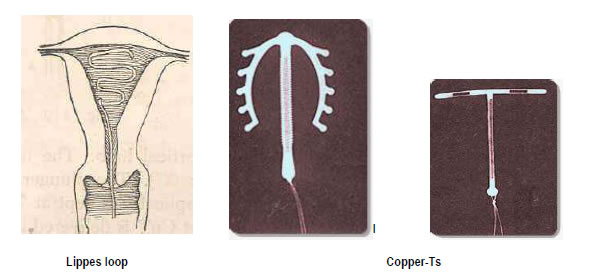
T-shaped structure which stays inside the uterus with the long arm of the T along the uterine cavity (endometrium) and the shorter arms transversely across the upper part of the endometrium.
Releases a progesterone called levonorgestrel. Works by affecting ovulation, affecting the normal growth of the endometrium and by affecting the cervical mucus so that the movement of sperm is obstructed. In the United Kingdom, hormone based IUDs are known as Intrauterine Systems (IUS).
These are more or less permanent methods of contraception
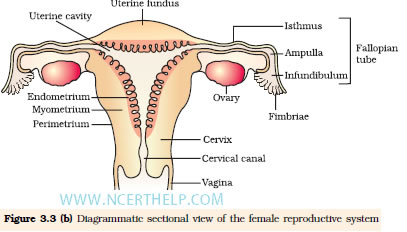
Both the female tubes are tied off and usually cut during tubal ligation to prevent the sperm from reaching the ovum during intercourse.
The two tubes which carry sperm from the testes to the penis are the vas deferens. Tying them off and cut.
♦ Essure: Essure is a method in which small micro-inserts are placed at the mouth of the fallopian tubes to cause scarring and block them. This prevents sperm from reaching the ovum for fertilization.
Occurs when a sperm meets with an ovum.
Ovum round about 100 microns in diameter.Ovum picked up by the fallopian tube on the same side.
Tubes have long fingerlike projections called fimbria which it uses, rather like hands to pick up the
ovum. Ovum moves through the tube, propelled along by long hairs growing from cells in the tubes.
Like grass bending before the wind, the hairs bend towards the uterus in waves, pushing the ovum
slowly towards the uterus. The egg remains viable, (alive) for about 72 hours, but is capable of being
fertilized for only about 12 - 24 hours. If it remains unfertilized during this period, it disintegrates in the tube without leaving any trace. Its end products (mainly proteins) are absorbed into the bloodstream and excreted through the urine or stool.
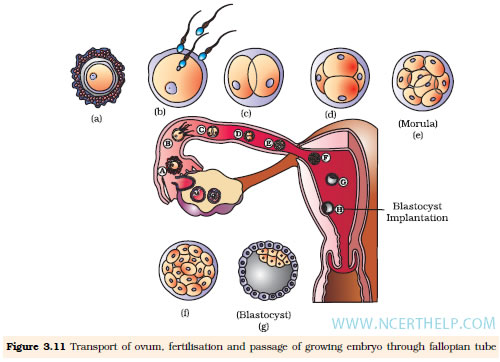
Sperm viable for a longer period, found in uterus 5 – 7 days after coitus. But capable of fertilizing an ovum for only 48 - 72 hours after being ejaculated. Time taken by sperm to reach tubes is between 6 – 12 hours but many authorities say it can be as early as 1 hour.
Intercourse has to take place within this narrow time frame (1-2 days before ovulation or immediately after ovulation), for a pregnancy to occur. At every intercourse normal man deposits 2 – 5 mililitre of semen in the upper part of the vagina (see diagram). Each mililitre of semen normally contains about 50 – 200 million of sperms.
Sperms swim rapidly upwards into the uterus and from there into the two tubes on either side at the rate of 3mm per hour. Takes an average of 10 hours for sperm to reach tubes.
All the sperms deposited in the vagina cannot swim into the uterus. Only about 1 % of the total number of sperms deposited in the vagina make the journey.
Hundreds of sperm (estimated to be around 300) surround All the sperms deposited in the vagina cannot swim into the uterus. Only about 1 % of the total number of sperms deposited in the vagina make the journey. Hundreds of sperm (estimated to be around 300) surround the ovum in the tube. They press against the membrane of the ovum attempting to penetrate it and fertilize the ovum. Finally one sperm succeeds. At once a chemical reaction is triggered off in the wall of the ovum, making it impenetrable to any other sperm. No other sperm can enter the ovum now.
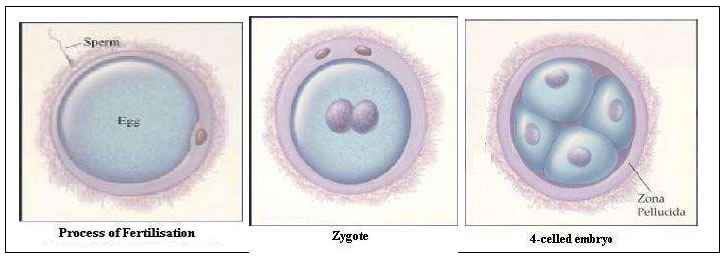
Unsuccessful sperms slowly degenerate, break down and become indistinguishable from any other protein end product in the female partner‘s body (sperm made up mainly of protein). These get absorbed into the blood stream, are carried away to be expelled from the body in the stool or the urine.
Sperm that manages to penetrate the ovum fuses with it to form a single cell called a zygote. Zygote starts to divide as it is propelled towards the uterus – dividing first into 2 cells, then into 4, then 8 and so on. Dividing zygote called an embryo.
When the process of in-vitro fertilization (IVF) is carried out, the ovum and the sperm is allowed to fertilize in a laboratory dish (petri dish). The embryo is usually transferred into the mother‘s uterus at the 4 – 8 celled stage, usually on the third day after fertilization.
By the time the zygote reaches the uterus at about the 6th to 9th day after ovulation, it is a 16-celled cluster of cells called a morula. The morula looks rather like a bunch of grapes. Each of its cells is identical to each other.
Theoretically, it is from the 2-celled to the 16-celled stages that the cells can be separated from each other and allowed to develop into clones of each other (identical twins). In nature, separation occurs spontaneously – usually at the 2-celled stage – to form identical twins. Separation at later stages can lead to the potentially fatal condition of conjoint twins or Siamese twins.
When it reaches the uterus, the morula sticks to the inner lining of the uterus (called the ’endometrium’). By this time, the hormone progesterone released by the ovaries finishes preparing the endometrium to receive the morula.
The morula burrows deep into the endometrium and by the 9th - 12th day after ovulation, is fully buried in it. Burrowing can cause a little bleeding called ‗implantation bleeding‘. Buried embryo begins to develop, Its cells increasing in number and gradually becoming different from each other in the way they function.
The development of the embryo continues until at the end of 9th month of pregnancy (40 weeks or 280 days), a fully formed baby, capable of leading a life independent from its mother is ready to be born.
‗Infertility‘ when a couple fails to conceive after one year of sexual life without contraception. 80% of all women desiring children, conceive within 1 year of marriage and another 10% within the second year
According to the World Health Organisation, incidence of infertility is about 10 % worldwide. Another 10-12% of all the other couples have only one child and wish to have more. The incidence of infertility is gradually increasing all over the world.
For many people going through infertility treatment, the level of distress and tension can be very high. Mutual trust and faith in the doctor can help the couples to enquire about different modalities of treatment for both the male as well as the female partner, and make informed decisions of their reproductive status azoospermia (complete absence of sperm). In these cases, sperm has been aspirated from the testes directly.
This method is used in men with moderately low sperm count. the semen is collected by masturbation, washed and centrifuged to increase the sperm density. This high density sperm sample is now injected into the uterus, bypassing the vagina. The chances of hostile cervical mucus is thus eliminated. Since the sperm is injected into the uterine cavity, chances of pregnancy is increased. The procedure should be done within 2 hours of collecting the semen.
This is done in cases of impenetrable cervical mucous or when disease or deformity of the cervix makes it impossible for the sperm to enter the uterus. It is also carried out in cases of impotence or premature ejaculation.
AID is usually carried out in couples where the husband suffers from azoospermia.
process by which egg cells are fertilised by sperm (usually 100,000 sperm / ml) outside the womb, in vitro. IVF is a major treatment in infertility when other methods of assisted reproductive technology have failed. The process involves hormonally controlling the ovulatory process, removing ova (eggs) from the woman’s ovaries and letting sperm fertilise them in a fluid medium. The fertilised egg (zygote) is then transferred to the patient’s uterus with the intent to establish a successful pregnancy. The first successful birth of a "test tube baby", Louise Brown, occurred in 1978. Prior to that, there was a transient biochemical pregnancy reported by Australian Foxton School researchers in 1973 and an ectopic pregnancy reported by Steptoe and Edwards in 1976.
In vitro, (Latin) meaning within the glass, biological experiments involving cultivation of tissues outside the living organism were carried out in glass containers such as beakers, test tubes, or petri dishes. Term in vitro used to refer to any biological procedure that is performed outside the organism. In vivo procedure, tissue remains inside the living organism within which it is normally found. A colloquial term for babies conceived as the result of IVF, test tube babies, However, in vitro fertilisation usually performed in shallow containers called Petri dishes. (made of glass or plastic resins.)
infertility treatment where blockage in the fallopian tubes prevents the normal binding of sperm to the egg.Egg cells removed from woman’s ovaries, and in vitro fertilised. Resulting zygote placed into the fallopian tube by laparoscopy. The procedure spin-off of the gamete intrafallopian transfer (GIFT) procedure. ZIFT has a success rate of 64.8% in all cases.
Takes an average five weeks to complete a cycle of ZIFT. First, the woman must take a fertility medication to stimulate egg production in the ovaries. The doctor will monitor growth of ovarian follicles, once they are mature, woman will be injected with human chorionic gonadotropins (hCG). Eggs will be harvested approximately 36 hours later, usually by transvaginal ovum retrieval. After fertilization in laboratory resulting early embryos or zygotes are placed into the woman’s fallopian tubes using laparoscope.
assisted reproductive technology against infertility. Eggs removed from a woman’s ovaries, placed in one of the Fallopian tubes, along with the man’s sperm. The technique, which was pioneered by endocrinologist Ricardo Asch, allows fertilization to take place inside the woman’s body. Takes, an average of four to six weeks to complete a cycle of GIFT. First, the woman must take a fertility drug to stimulate egg production in the ovaries. The doctor will monitor growth of ovarian follicles, once they mature, woman will be injected with Human chorionic gonadotropin (hCG). The eggs will be harvested pproximately 36 hours later, mixed with the man’s sperm, and placed back into the woman’s Fallopian tubes using laparoscope.
technique in which a single sperm injected into the centre of the egg, in order to achieve fertilization. Sperm is collected from the male partner by masturbation. Single healthy sperm then injected into the prepared ovum. The advantage of this method is that only a single sperm is needed - even men with a very low sperm count can become fathers with this treatment. Men found to be azoospermic, that is with no sperm at all in the semen, sperm can be suctioned out of the vas deferens ( male tubes). Sperm can also be liberated from the testes itself by careful testicular biopsy and culture by a method called MESA Microepididymal sperm aspiration.
Undescended testes should be treated at the earliest during infancy before testicular function is damaged. Infections by mumps and other viruses should be managed by keeping a watchful eye on complications in the testes.
Sexually transmitted diseases (also called STDs, or STIs for sexually transmitted infections): Infections transferred from one person to another through sexual contact. According to the Centers for Disease Control and Prevention, there are over 15 million STD cases reported annually in the United States. More than 25 diseases that are transmitted through sexual activity. Other than HIV, the most common STDs in the United States are chlamydia, gonorrhea, syphilis, genital herpes, human papillomavirus, hepatitis B, trichomoniasis, and bacterial vaginosis. Adolescents and young adults are the age groups at greatest risk for acquiring an STD. Approximately 19 million new infections occur each year, almost half of them among people ages 15 to 24.
Some STDs can have severe consequences, especially in women, if not treated, which is why it is so important to go for STD testing. Some STDs can lead to pelvic inflammatory disease, which can cause infertility, while others may even be fatal. STDs can be prevented by refraining from sexual activity, and to a certain extent, some contraceptive devices, such as condoms.
Thought to be one of the main causes of cervical cancer. Has been linked with other types of cancers of female reproductive system. HPV can be treated to reduce signs and symptoms. Currently no cure for this virus. HPV vaccine recently developed to prevent HPV infection. Herpes Virus: STD that presently with no cure. Treatment available. Home remedies & natural treatmentavailable. Herpes symptoms include blisters or sores that periodically break out on the genitals. Refer FAQs.
To cure for those already infected, a Hepatitis B (HBV) vaccine available to prevent spread of this infection. Many are asymptomatic, however those who do suffer from Hepatitis B symptoms may have many unpleasant discomforts. Infection may clear up on its own. Some people may suffer from chronic infections for many years. Treatment available for chronic sufferers. Other types of hepatitis infections that can be passed through sexual contact include Hepatitis A and Hepatitis C.
Most dreaded STD. New ways of treating this infection significantly prolongs an infected person’s life. For many this infection eventually progresses to AIDS and, ulitmately, death. More than 40 million people worldwide are infected with the HIV virus; women account for 50% of those infected. Syphilis: Throughout history, cases of syphilis have been recorded. Can easily be treated and cured. Without treatment, syphilis symptoms can progress and affect the nervous system and brain leading to dementia and even death.
Throughout history, cases of syphilis have been recorded. Can easily be treated and cured. Without treatment, syphilis symptoms can progress and affect the nervous system and brain leading to dementia and even death.
most common, curable STDs. However, symptoms may be mistaken for a yeast infection causing women to use wrong type of treatment for her vaginal discharge.
Chlamydia and gonorrhea often infect a person at the same time. Although the symptoms of chlamydia are different from gonorrhea not unusual for person to be asymptomatic. If testing for chlamydia, good idea to test for gonorrhea. Both STDs can be cured but can damage reproductive system if left untreated.
Crabs are very similar to head lice. Itchy symptoms can be hard to miss. Treatment for pubic lice can easily take care of the discomfort these pests can cause.
Rare Infections:Granuloma inguinale and chancroid,. Other lesser-talked about STDs include nongonococcal urethritis and molluscum contagiosum,
• Swelling or tenderness in genital area.
• Blisters ,sores or bumps around the mouth or genitals.
• Fever,chills and aches.
• Unusual itching.
• Burning sensation when you pass urine or move your bowels.
• White,watery or yellow disharge from the penis.
• Have fewer symptoms than men, often none at all. STDs can lead to cancer. Women should watch for-
• Bleeding that is not part of their period.
• Pelvic or vaginal pain.
• Discharge from the vagina.
• Painful urination.
• Unusual rash, sore or growth in the genital area.
Pelvic inflammatory disease (PID) is infection of a woman’s reproductive organs. Infection spreads
upward from the cervix to the uterus, Fallopian tubes, ovaries, and surrounding structures
Pelvic Inflammatory Disease (PID) Symptoms
If a woman has PID, she may have any of these symptoms:
• Abdominal pain (especially lower abdominal pain) or tenderness
• Back pain
• Abnormal uterine bleeding
• Unusual or heavy vaginal discharge
• Painful urination
• Painful sexual intercourse
• Symptoms not related to the female reproductive organs include fever, nausea, and vomiting.
PID symptoms may be worse at the end of a menstrual period and during the first several days following a period.
Pregnancy that develops outside a woman’s uterus womb).When the fertilized egg from ovary does not implant itself normally in the uterus. Egg develops somewhere else in the abdomen. Such conceptions are abnormal and cannot develop into a fetus.
• Common ectopic pregnancy in fallopian tubes (so-called tubal pregnancy). Also found on the
outside of the uterus, on the ovaries, or attached to the bowel.
• Complication of ectopic pregnancy is intra-abdominal hemorrhage (severe bleeding). Eg. tubal
pregnancy the products of conception continues to grow in the fallopian tube, tube expands
and eventually ruptures. This can be very dangerous because a large artery runs on the
outside of each fallopian tube. If the artery ruptures, you can bleed severely.
• Ectopic pregnancy usually found in the first 5-10 weeks of pregnancy
| IN MALES | IN FEMALES |
| Oligospermia: Low sperm count | Anovulation: Absence of ovulation. |
| Azospermia: Absence of sperm. | Oligoovulation: Deficient ovulation. |
| Asthenozoospermia: Low sperm motility. | Hyperprolactinemia: Ovum remain trapped inside the follicle. |
| Teratozoospermia: Defective sperm morphology. |
Idiopathic Infertility: Failure or abnormal fertilization. |
| Cryptorchidism:Failure of Testes to descend in the scrotal sac. |
Tubal Infertility: Damaged/ligated fallopian tube |
S.no |
STD |
CAUSAL AGENT |
| 1 | CHLAMYDIOSIS | Chlamydia trachomatis |
| 2 | GONORRHOEA | Nisseria gonorrhea |
| 3 | TRICHOMONIASIS | Tricomonas vaginalis |
| 4 | GENITAL HERPES | Herpes simplex virus |
| 5 | SYPHILIS | Trepanema pallidum |
| 6 | GENITAL WART | Human papilloma virus |
| 7 | HEPATITIS-B | Hepatitis –B virus |
| 8 | AIDS | HIV |
SYMPTOMS |
EFFECT ON FOETUS |
EFFECT ON PERSON AFFECTED |
| Painful rination & intercourse Mucus discharge from penis/vagina | Premature birth,blindness, Pneumonia |
Pelvic inflammatory disease, Infertility,Ectopic pregnancy |
| Painful urination in men |
Still birth, Blindness |
Pelvic inflammatory disease, Infertility,Rash,Death |
| Inflammation, Itching& vaginal white discharge (Leucorrhoea) | Not known | Valvar erythema, Burning dysuria |
| Genital sores, Fever | Still birth, Brain damage |
Cervical cancer. |
| Initially sores in genitalia & mouth, Rashes | Premature birth, Miscarriage, Still birth | Death |
| Warts on genitalia | Not known | Cervical cancer |
| Fatigue, Fever, Jaundice, Rash, Abdominal pain | Low birth weight | Liver cirrhosis, Liver cancer |
| Fever, Prone to infection, Inflammation | AIDS affected | Dementia, Death |
• Indian population is identified as ‗Young population‘ whereas population of USA, England
,Germany etc. are identified as ‗Ageing population‘.
• In India, Kerala has lowest Birth rate & U.P. highest.
• Deficiency of Manganese causes infertility & Vitamin E is considered as Antisterility Vitamin.
• 11th July celebrated as World Population Day.
• Every 16th person in the world is an Indian.
• Main objectives of National Population Policy, 2000 are : population stabilization, compulsory school education, reduce infant mortality rate, decrease fertility rate, promote delayed
marriage, incentive for sterilization, restrain child marriage etc.
• Kerala declared as the ‗ First baby friendly state of the world‘ by first Human Development
Report 2002.
• I-pills or Intelligent pills are Emergency Contraceptive pills that should be used in emergency only.Frequent use of it may bring ovarian damage & Menstrual problem.
• Contraceptive Corn: Scientists have produced a genetically modified corn crop which produces antisperm antibodies &suggest that a plant based jelly may be prepared which will prevent pregnancy & spread of STDs simultaneously.
AMNIOCENTESIS: Foetal test based on chromosomal pattern in amniotic fluid surrounding the developing embryo. can be used for sex determination.
LACTATIONAL AMENORIA: Absence of menstruation due to disruption of ovulation during the period of intense lactation following parturition.
INTRA UTERINE DEVICES(IUDs): A medical device of insertion of artificial barrier in the uterus through vagina for obstructing sperm entry.
STERILISATION: Surgical intervention for stopping pregnancy by blocking gamete transport pathway in male/female.
ASSISTED REPRODUCTIVE TECHNOLOGIES(ART): Artificial technological devices to enable couples to have children when fail they to get child due to any reproductive disorder.
ARTIFICIAL INSEMINATION: Medical technological devices by which semen collected from a healthy donor is artificially introduced into the vagina or uterus of female.
ETIOLOGY:Study of causes of diseases.
EPIDEMIOLOGY:Mode of transmission of diseases
RECANALISATION: Attachment of cut Vasa deferentia with plastic tubes during Vasectomy.
CASTRATION: Surgical removal of Testes.
POPULATION CRASH: Rapid decline in the population.
POPULATION EXPLOSION: Rapid increase in the population.
AGE COMPOSITION: Relative abundance of the organisms of different ages in the population.
IN-VITRO FERTILISATION: Artificial technique of fusion of gametes outside the body in laboratory condition, in almost similar conditions as that of the body.
INFERTILITY: Inability of a couple to produce children in spite of unprotected sexual cohabitation.
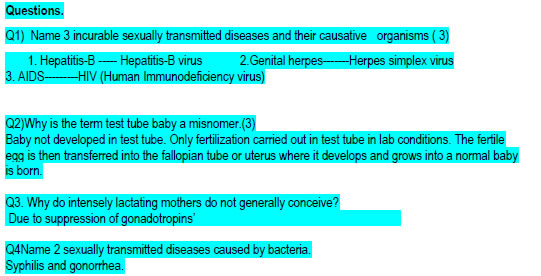
Copyright @ ncerthelp.com A free educational website for CBSE, ICSE and UP board.